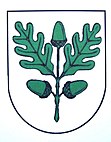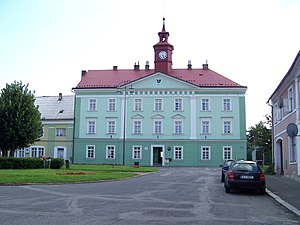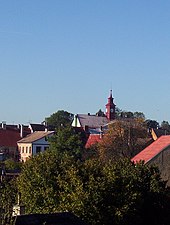Dubá
| Dubá | ||||
|---|---|---|---|---|
|
||||
| Basic data | ||||
| State : |
|
|||
| Region : | Liberecký kraj | |||
| District : | Česká Lípa | |||
| Area : | 6059.3192 ha | |||
| Geographic location : | 50 ° 32 ' N , 14 ° 32' E | |||
| Height: | 266 m nm | |||
| Residents : | 1,723 (Jan 1, 2019) | |||
| Postal code : | 471 01-471 41 | |||
| License plate : | L. | |||
| structure | ||||
| Status: | city | |||
| Districts: | 20th | |||
| administration | ||||
| Mayor : | Zdeňka Šepsová (status: 2007) | |||
| Address: | Masarykovo náměstí 138 471 41 Dubá |
|||
| Municipality number: | 561533 | |||
| Website : | www.mestoduba.cz | |||
| Location of Dubá in the Česká Lípa district | ||||

|
||||
Dubá (German Dauba ) is a city of the Okres Česká Lípa in the Liberec region in the Czech Republic .
Geographical location
The city is located in the north of Bohemia .
history
Dubá is an old Slavic settlement and prehistoric market. Numerous bone finds and jewelry from the reign of Vratislav II bear witness to this . The dynasty of the lords of Dubá has been tangible since the 13th century . Later the city and its lordship came to the branch of the Berka of Dubá . After 1622 the Waldstein family took over the rule; after that, Walter Butler , Sweert-Sporck, Barbara O'Reilly, Ernst von Waldstein, Baron Maglič and finally the Waldsteins on Neuperstein (Nový Berštejn) again resided until they were confiscated in 1945 .
The city's development was hampered by some negative events. In addition to the plague and wars, there were numerous fires. Dauba was not connected to the railway network that was built in the 19th century, so that no industrial companies settled in the city.
After the First World War , the German-populated city was added to the newly created Czechoslovakia in 1919 . Since the Munich Agreement , the city belonged from 1938 to 1945 to the district of Dauba in the Reichsgau Sudetenland , administrative district of Aussig , of the German Reich . The city of Dauba had 1,565 inhabitants on December 1, 1930, and 1,474 on May 17, 1939.
The river Liběchovka rises east of Nový Berštejn (New Perstein) and flows around the place in a wide arc. It is dammed at Mlýnek (Women's Mill) in the Černý rybník (Black Pond) , where there is a campsite. Below this pond, the valley of the river, which was previously used as pastureland, has been left in its natural state since the middle of the 20th century. The Liběchovka valley south of Dubá is now a marshland and has been declared a nature reserve.
Demographics
Until 1945 Dauba was predominantly populated by German Bohemia , which were expelled.
| year | Residents | Remarks |
|---|---|---|
| 1830 | 1,254 | in 213 houses |
| 1900 | 1,896 | German residents |
| 1930 | 1,417 | including 167 Czechs |
| 1939 | 1,472 |
| year | 1947 | 1970 | 1980 | 1991 | 2001 | 2003 |
|---|---|---|---|---|---|---|
| Residents | 1,237 | 2.116 | 1999 | 1,723 | 1,757 | 1,753 |
City structure
The city consists of 20 districts with numerous other places to live:
- Bukovec (Buckholz) with Bukovecký Mlýn (Buckholz mill)
- Deštná (Töschen)
- Dražejov (Draschen) with Heřmánky u Dražejova (deer coat at Draschen)
- Dřevčice (Sebitsch) with Dolský Mlýn (Gründelmühle) , Máselenik (Butterberg) and Poustka (Pauska)
- Dubá (Dauba) with Krčma (Kratschen) , Rozprechtice (Roßpresse) and Vrabcov (Frapsgraben)
- Heřmánky (deer coat on the Willhoscht) with Dolní Heřmánky (lower deer coat) and Horní Heřmánky ( top deer coat )
- Horky (Horka) with Horecký Důl ( Horkagrund )
- Horní Dubová Hora (Upper Eichberg)
- Kluk (Kluck)
- Korce (Kortschen)
- Křenov (Schönau) with Křenovský Mlýn (Schönau Mill)
- Lhota (Wellhütta)
- Nedamov (Nedam) with Březinka (Brezinka) and Mlýnek ( women's mill )
- Nedvězí (Nedoweska)
- Nový Berštejn (Neuperstein)
- Panská Ves (Herrndorf)
- Plešivec (Kahlenberg)
- Sušice (Oschitz)
- Zakšín (Sakschen) with Zakšínský Vrch (house ridge)
- Zátyní (Sattai) with Lešnice ( Leschnitz )
Basic settlement units are Bukovec, Deštná, Dražejov, Dřevčice, Dubá, Heřmánky, Horky, Korce, Křenov, Lhota, Nedamov, Nedvězí, Nový Berštejn, Panská Ves, Plešivec, Zakšín and Zátyní.
The area extends from the 614 m high Vlhošť (Willhoscht) in the north to the sandstone cliffs of Daubaer Schweiz in the south. Many of the small settlement areas are Slavic rounds and are scattered on the plateaus. The population of these places has fallen sharply, and several settlements now consist entirely of holiday homes. Some of these settlements were completely abandoned in the 20th century and no longer exist.
The municipal area is divided into the cadastral districts of Deštná u Dubé, Dražejov u Dubé, Dřevčice, Dubá, Heřmánky, Horky u Dubé, Korce, Lhota u Dřevčic, Nedamov, Zakšín and Zátyní.
Attractions
- The Church of the Discovery of the Cross was built in the mid-18th century in the Baroque style. It was designed by Anselmo Lurago . Inside you will find numerous paintings and carvings as well as an organ decorated with angels.
- Technical monument hop kiln , commemorates the time when hops were grown in the area.
- Houska Castle near Blatce
- Chudý Hrádek Castle near Dolský Mlýn (Gründelmühle)
- Čap near Tuhaň
- Starý Berštejn Castle near Vrchovany
sons and daughters of the town
- Franz Xaver Steinmetzer (1879–1945), Roman Catholic theologian, religious scholar, orientalist, Assyriologist and author
- Ernst Nepo (1895–1971), Austrian painter
- Adalbert Langer (1905–1994), German lawyer
- Berthold Seliger (1928–2020), German rocket designer
- Wilhelm Topsch (* 1941), German educator and writer
- Alfred Kirpal (1944–2010), German electrical engineer
Web links
Individual evidence
- ↑ http://www.uir.cz/obec/561533/Duba
- ↑ Český statistický úřad - The population of the Czech municipalities as of January 1, 2019 (PDF; 7.4 MiB)
- ↑ Yearbooks of the Bohemian Museum of Natural and Regional Studies, History, Art and Literature . Volume 2, Prague 1831, p. 196, paragraph 28.
- ↑ Johann Gottfried Sommer : The Kingdom of Bohemia . Volume 2: Bunzlauer Kreis , Prague 1834, p. 167, paragraph 13.
- ^ Meyer's Large Conversational Lexicon . 6th edition, Volume 4, Leipzig and Vienna 1906, p. 540 .
- ^ A b Michael Rademacher: German administrative history from the unification of the empire in 1871 to the reunification in 1990. Dauba district. (Online material for the dissertation, Osnabrück 2006).
- ↑ http://www.czso.cz Czeski Urząd Statystyczny
- ↑ http://www.uir.cz/casti-obce-obec/561533/Obec-Duba
- ↑ http://www.uir.cz/zsj-obec/561533/Obec-Duba
- ↑ http://www.uir.cz/katastralni-uzemi-obec/561533/Obec-Duba




